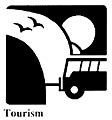|
Tourism
 Issues Issues
- Role and structure of the tourism industry.
- Potential environmental impacts of tourism.
- Potential social and cultural impacts of
tourism.
- Land use and planning responsibilities within and
between spheres of govemment.
Summary of Final Report
Tourism is an industry that is capable of contributing to
sound economic development and substantial employment
generation in Australia 's over the coming years. Because of
the complementarities that exist between tourism and the
environment, it will be in the best interest of both
economic and ecological values if the tourism industry
develops in accordance with the principles of ESD.
General environmental impacts of tourism include those resulting from
the development of tourism infrastructure and facilities and those arising
from the presence of tourists themselves.
A growing proportion of international and domestic
tourists are seeking what can be described as alternative or
cultural tourism as a major component of their holiday,
embracing experiences that have a specific educational,
cultural, or scientific focus.
Key recommendations:
- that ongoing ESD decision-making processes should
continue to emphasise the cooperative involvement of all
stakeholders, including governments, industry and
conservation organisations; indigenous people should also
be represented in this process;
- governmental recognition in legislation that
integrated land use plans, based on ecological systems or
biophysical regions, are the central components of a
multi-tiered land use planning process.
environmental impact assessment:
- conduct EIA's to determine the cumulative,
interactive and long-term environmental impacts of
development projects on neighbouring areas and regional
resources;
- EIA be extended to formally include assessment of the
social and cultural impacts of any proposed
development;
- national guide-lines on the application of EIA be
developed and ratified intergovernmentally;
- nationally recognised accreditation system for
individuals and organisations preparing environmental
impact statements (EIS);
- appropriate authorities address restrictions and
inhibitions to community participation in the EIA process
to ensure that such participation is facilitated at the
earliest possible opportunity;
- strategic tourism plans be developed by State and
Territory Governments in collaboration with local
governments and tourism industry bodies;
funding and fees:
- governments provide adequate budget funding to ensure
that protected areas are managed and maintained to the
highest standard;
- governments introduce, or review, systems of park-use
fees so that those using facilities and/or services in
protected areas contribute directly to the costs of
management.;
indigenous people:
- information about the possibilities of participation
of indigenous people in the tourism industry be made
available;
- the tourism industry be provided with accurate
information about the cultural diversity of indigenous
people;
- market research be undertaken to identify potential
commercial opportunities and scope for indigenous
peoples' involvement or employment in tourism;
- assessment of education and training needs of
indigenous people in tourism.
The Working Group recommends that industry codes of
environmental practice continue to be developed, implemented
and reviewed and that industry performance in implementing
such codes be audited.
Other areas that the Working Group made recommendations
on include the development of marketing strategies and
campaigns which incorporate ESD goals; the establishment of
criteria and conditions under which commercial activities
within protected areas may be appropriate; performance bonds
as a condition of development approval where there is a risk
of unacceptable environmental damage; accurate pre-visit
information, interpretation programs and internationally
recognised signage, and provision of interpretation in
languages other than English; the need for a code of
behaviour for tourists based on ESD principles; community
participation; the incorporation of ESD principles into
education and training curricula; and the need for market
research to make an accurate assessment of international
visitors' demand for types of tourism, particularly
ecotourism.
Source: ESD Newsbrief, No 5, December 1991
Back...

|
 Issues
Issues